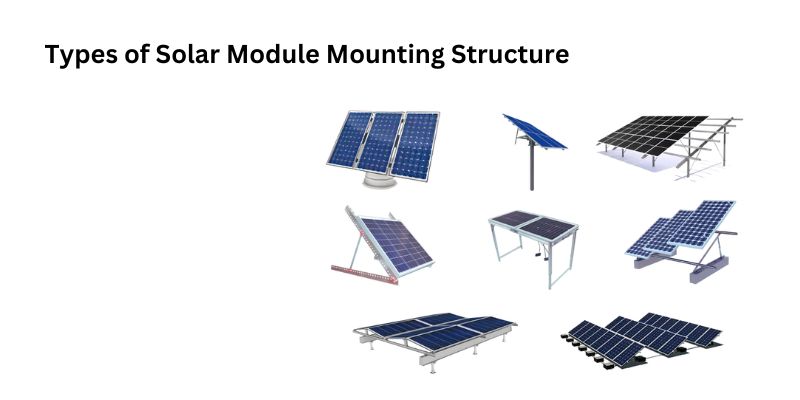5 Different Types of Solar Module Mounting Structures

Solar energy plays a critical role in our shift toward sustainability. The effectiveness of solar panels relies not just on the photovoltaic cells but also on the structures that support them. In this guide, we’ll explore the different types of solar mounting structures.
What Is a Solar Panel Mounting Structure?
Solar panels are built with strong glass layers, but they can still get damaged if not set up properly. That’s why they need something solid to hold them in place—this is called a mounting structure. It keeps the panels secure and slightly raised off the ground. These mounts are usually made from rust-proof metal and include parts like rails, clamps, and screws. Depending on where and how you want to generate electricity, there are different types of mounting systems to choose from.
- Roof-Mounted Solar Structures
For residential and commercial properties with limited ground space, roof-mounted solar structures are a highly effective alternative. Common options include ballasted systems, which rely on weight for stability and are well-suited for flat roofs; penetrating systems, which attach directly to the roof structure to ensure stability in high-wind conditions; and hybrid systems which integrate ballast and penetration for enhanced versatility.
Pros of Rooftop Solar Mounting
- Easy to clean and maintain the solar panels.
- Affordable to install, with lower costs.
- Makes good use of your unused rooftop space to generate free electricity.
Cons of Rooftop Solar Mounting
- Drilling into the roof may cause some wear or damage over time.
- The roof needs to be clear of any shadows, like trees or buildings.
- Panels must be placed in the right direction to get the best sunlight.
- Ground-Mounted Solar Structures
Ground-mounted solar structures are frequently employed in utility-scale solar installations due to their scalability and efficiency. The primary configurations include:
Fixed-tilt systems, are valued for their simplicity and cost-effectiveness.
Single-axis trackers, improve energy yield by tracking the sun’s horizontal movement.
Dual-axis trackers offer superior energy optimization by adjusting to both horizontal and vertical solar angles, albeit with increased complexity and cost.
This discussion evaluates the trade-offs of each system in terms of installation complexity, cost, and energy output optimization.
Pros of Ground-Mounted Solar Systems
- You can adjust the panels easily depending on the season to get the best sunlight.
- It’s simple to check, clean, or fix the panels since they’re on the ground.
- If you’ve got extra space, it’s easy to add more panels later.
Cons of Ground-Mounted Solar Systems
- Finding open ground with no shade from trees or buildings can be hard.
- These systems aren’t ideal for crowded areas where space is limited.
- They might not look great in your yard, especially for home use.
- Floating Solar Structures
Floating solar structures are an exciting innovation in renewable energy, utilizing the vast surface area of water bodies like lakes, reservoirs, and even oceans. These systems not only save valuable land but also help minimize water evaporation, making them a dual-purpose solution. This guide explores the advantages, such as increased energy efficiency, and the challenges, like their impact on aquatic ecosystems and the engineering complexities of designing for water environments.
Pros of Floating Solar Mounting Systems
- Makes use of unused water areas like lakes, dams, and reservoirs.
- Helps save water by reducing how much evaporates from the surface.
- You don’t need to prepare land or buy property, which can save money.
Cons of Floating Solar Mounting Systems
- Best suited for large solar farms, not homes or small projects.
- Only works in places where there are calm, steady water bodies.
- Pole-Mounted Solar Structures
Pole-mounted solar structures are a flexible option that works well for both residential and commercial properties. By elevating the panels, these systems reduce shading and improve sunlight exposure. This guide takes a closer look at how pole-mounted systems are designed and installed while highlighting their benefits in terms of space-saving and easier maintenance.
Pros of Pole-Mounted Solar Panels
- Great option when there’s not much space on the ground.
- Can be placed higher up to avoid shadows from trees and plants, so they get more sunlight.
- Being elevated also helps protect the panels from tampering or accidental damage.
Cons of Pole-Mounted Solar Panels
- Usually works best for smaller solar setups.
- Since it’s supported by just one pole, it might be at risk during strong storms or high winds.
5. Solar Carport Structures
Solar carports are an innovative solution that combines shaded parking with the power of solar energy. Typically found in commercial parking lots, these structures help protect vehicles from the sun while also generating clean, renewable energy. This guide delves into the design, installation process, and economic advantages of solar carports, showing why they’re a great option for businesses seeking to adopt solar energy.
Conclusion:The world is moving towards cleaner energy, and picking the right solar mounting system can make a big difference! KP Green Engineering specialises in streamlining your solar installation process by providing expert guidance on selecting the most suitable solar module mounting structures and advanced technology solutions. Our manufacturing facilities are equipped to produce a wide range of profiles to support all types of solar panel module mounting structures for SPV power plant projects.



